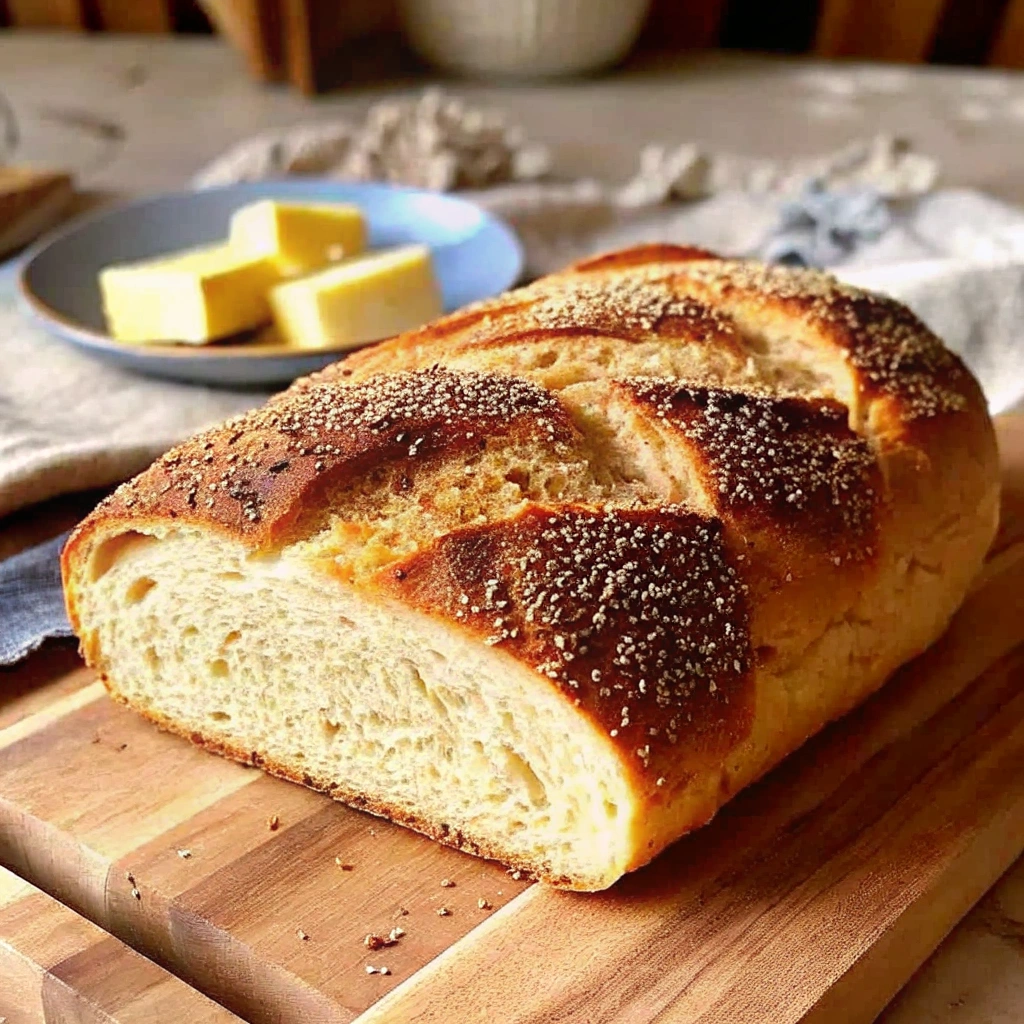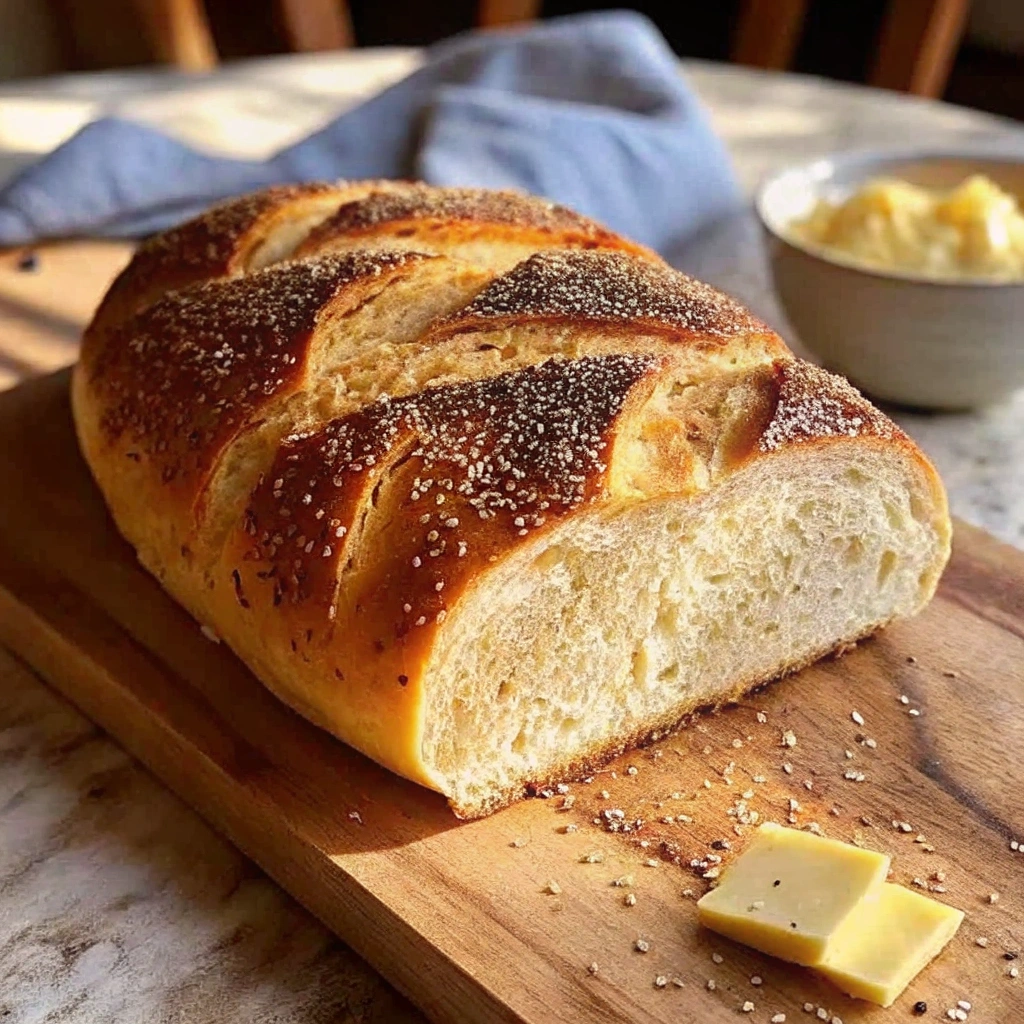
The aroma of freshly baked German bread (known as Brot) is unmistakable—it’s earthy, hearty, and deeply satisfying. Traditional German loaves, like Vollkornbrot or rye bread, are famous for their dense, moist crumb and incredible depth of flavor. However, they typically require long fermentation periods, sourdough starters, and precise temperature control.
This 5-Minute No-Knead German Seed Bread is the clever, modern solution. It captures the complex flavor, dark color, and satisfyingly dense texture of authentic loaves but requires only five minutes of hands-on mixing time. By using a blend of healthy, dense flours and harnessing the power of baking soda and buttermilk, we create a quick bread that skips the yeast, kneading, and long proofing, delivering a hearty loaf that is perfect for slicing, toasting, and enjoying with butter and cheese.
If you’re ready for a simple no-knead recipe that tastes like it came straight from a German bakery, this is the one. Get ready to enjoy the rich, rustic flavors of Europe with almost no effort!
Why This German Quick Bread Works
This recipe achieves the rich texture and flavor of traditional rye bread without yeast by focusing on three key elements: specialized flours, fast leavening, and essential seeds.
- Flour Blend for Density: Traditional German bread is heavy because it uses a high percentage of whole grains (like rye or whole wheat). This recipe mimics that density by combining all-purpose flour for structure with rye flour and whole wheat flour for that unmistakable earthy flavor and texture. Rye flour has less gluten, which naturally leads to a denser, more cohesive loaf.
- Chemical Leavening: Instead of yeast, we use baking soda and baking powder activated by an acid (buttermilk or yogurt). This creates a quick, powerful lift that sets the bread structure almost immediately, eliminating the multi-hour proofing process.
- The Buttermilk/Acid: Buttermilk not only provides the necessary acid for leavening, but its fat content also contributes to a wonderfully moist crumb. This prevents the high-fiber flours from drying out during baking.
- The Seeds: A hallmark of authentic German Brot is the texture provided by seeds. We use a combination (sunflower, flax, pumpkin) that adds fiber, nutrition, and a satisfying, wholesome crunch.
Ingredients
Gathering the right blend of flours is essential for achieving the correct texture and traditional German flavor.
Dry Ingredients
- 1 cup (120g) All-Purpose Flour
- 1 cup (120g) Whole Wheat Flour
- $1/2$ cup (60g) Dark or Light Rye Flour (essential for flavor)
- 1 teaspoon Baking Soda
- 1 teaspoon Baking Powder
- 1 teaspoon Kosher Salt
- 2 tablespoons light brown sugar or blackstrap molasses (for color and depth)
- $1/4$ cup mixed seeds (sunflower, flax, pumpkin, or chia) plus 2 tablespoons for topping
Wet Ingredients
- 2 cups (480ml) Buttermilk (whole milk is fine if you add 1 Tbsp vinegar/lemon juice)
- $1/4$ cup strong brewed coffee (cooled, optional but enhances color and flavor)
- 2 tablespoons olive oil or neutral oil
Equipment
- 9×5-inch loaf pan
- Parchment paper
- Large mixing bowl
- Wire rack
Step-by-Step Instructions: The 5-Minute Mix
The beauty of this recipe is that the entire batter comes together in less than five minutes. Remember: no kneading required!
Part 1: Mixing the Batter (5 Minutes)
- Prep Oven and Pan: Preheat your oven to $375^\circ F$ ($190^\circ C$). Line a 9×5-inch loaf pan with parchment paper, leaving an overhang on the long sides for easy removal.
- Combine Dry Ingredients: In a large bowl, whisk together the all-purpose flour, whole wheat flour, rye flour, baking soda, baking powder, salt, brown sugar/molasses, and the $1/4$ cup of mixed seeds. Ensure everything is evenly distributed.
- Combine Wet Ingredients: In a separate medium bowl, whisk together the buttermilk, cooled coffee (if using), and olive oil.
- Gentle Mix: Pour the wet ingredients into the dry ingredients. Use a large wooden spoon or spatula and mix only until the flour streaks have just disappeared. The batter will be very thick, heavy, and lumpy. Do not overmix!
Part 2: Baking and Cooling (65 Minutes)
- Fill and Top: Transfer the thick batter to the prepared loaf pan and spread it out evenly with a spatula. It will be dense.
- Seed Topping: Brush the top lightly with a bit of water or milk, and sprinkle generously with the reserved 2 tablespoons of mixed seeds.
- Bake: Bake for 55–65 minutes.
- Check Doneness: The loaf is done when the top is dark brown and crusty, and a wooden skewer or toothpick inserted into the center comes out clean or with just a few moist crumbs. The internal temperature should be around $200^\circ F$ ($93^\circ C$).
- Cool Completely: Remove the pan from the oven. Use the parchment paper overhang to lift the loaf out and transfer it to a wire rack. Let it cool completely for at least 1 hour before slicing. This step is non-negotiable! Slicing too early results in a gummy, wet interior due to the density of the rye flour.
Pro Tips for the Perfect Hearty Loaf

The high percentage of whole grains and the quick bread method require specific attention to ensure your loaf is moist and not gummy.
- Don’t Overmix: This is the most critical rule for quick bread. Over-mixing develops gluten, which is tough, and will result in a dense, chewy loaf with tunnels. Mix only until the dry ingredients are barely incorporated. Lumps are fine!
- The Density Check: Due to the rye and whole wheat flours, this bread is designed to be dense—it won’t rise like a fluffy yeast bread. Do not be concerned if it feels heavy; that’s the signature German texture!
- Measure Flours Precisely: If you simply scoop flour directly from the bag with a measuring cup, you risk adding up to 25% too much flour, which will make the bread dry and crumbly. Always spoon the flour into the measuring cup and then level it off with a straight edge.
- Bake Until Dark: German breads are often baked to a darker color than typical white loaves. Don’t be afraid of the deep brown crust; it adds to the rustic flavor and ensures the dense interior is fully cooked.
- Rye Substitution: If you don’t have rye flour, you can substitute the $1/2$ cup of rye with $1/4$ cup of whole wheat flour and $1/4$ cup of all-purpose flour, but the traditional flavor will be less pronounced.
Serving Suggestions and Creative Variations
This German Bread is best enjoyed simply, allowing its hearty flavor to shine. It’s perfect for everything from breakfast to a substantial lunch.
Serving Suggestions
- Classic German Frühstück (Breakfast): Serve thick slices toasted, topped with salted butter, cream cheese, or classic German preserves (like black cherry jam).
- Savory Toppings: Use it as the base for open-faced sandwiches (Butterbrot) topped with thinly sliced Swiss cheese, smoked salmon, or ham.
- Soup Dipper: This dense loaf holds up beautifully to rich, saucy dishes and soups like Creamy German Goulash or a hearty pea soup.
- Avocado Toast: Its robust flavor is a perfect counterpoint to creamy mashed avocado, red pepper flakes, and a squeeze of lime.
Creative Variations
- Dark Pumpernickel Flavor: Replace the brown sugar with blackstrap molasses and swap the coffee for $1/4$ cup of stout beer. This will give you a deeper, almost pumpernickel-like complexity.
- Onion and Dill: Sauté $1/2$ cup of finely diced onion until soft. Add 1 tablespoon of dried dill to the batter. The sweet onions deepen the savory profile.
- Sourdough Starter Discard: If you maintain a sourdough starter, you can add $1/2$ cup of unfed starter discard to the wet ingredients. It won’t leaven the loaf (the baking powder does that), but it will add a wonderful, characteristic tanginess.
- Crusty Top: For an even crunchier crust, after topping the loaf with seeds, spritz the entire surface lightly with water before placing it in the oven.
Frequently Asked Questions (FAQ)
- Why is my bread gummy or sticky in the middle? This is the most common issue with high-rye or whole-grain quick breads and is almost always caused by slicing the bread too soon. The dense flour needs the residual heat to fully set after coming out of the oven. You must wait at least one hour (or ideally two hours) until it is completely cool before slicing. If it’s still gummy after cooling, it was likely slightly under-baked; add 5-10 minutes to the next bake.
- Can I make this dairy-free or vegan? Yes! Substitute the buttermilk with an equal amount of plant-based milk (like soy or oat) mixed with 1 tablespoon of apple cider vinegar (let it sit for 5 minutes). Ensure your chocolate chips/molasses are vegan-certified if using them.
- How do I store this German Bread? Store the cooled loaf in an airtight container or a paper bag at room temperature for up to 5 days. Unlike plain white bread, the density of this loaf helps keep it fresh and moist longer. For longer storage, freeze the whole loaf (wrapped tightly in plastic wrap, then foil) for up to 3 months.
- Can I use all-purpose flour for the entire recipe? While you can, the finished product will not taste like authentic German bread. The dark color, earthy flavor, and signature density come specifically from the whole wheat and rye flours. For the best result, aim for at least 30-50% whole grain flour.
- Can I use a Dutch oven for this recipe? Yes, but the method changes slightly. Place the dough directly into a parchment-lined, preheated Dutch oven. Bake covered for 30 minutes, then uncovered for 25-30 minutes to achieve the crust. The internal temperature should still be $200^\circ F$ ($93^\circ C$).
This 5-Minute No-Knead German Seed Bread is simple, healthy, and provides the ultimate hearty comfort. Enjoy the ease of baking a truly authentic-tasting loaf with just a few minutes of effort!
Don’t forget to Pin this easy quick bread recipe and share what you topped your first slice with!

5-Minute No-Knead German Seed Bread
Ingredients
Equipment
Method
- In a large mixing bowl, whisk together flour, sugar, baking powder, and salt until evenly combined.
- Add warm water and olive oil to the dry ingredients. Stir with a wooden spoon or spatula until a sticky dough forms.
- Transfer dough to a lightly floured surface and knead briefly for about 1 minute. Shape into a round loaf or smaller rolls.
- Place shaped dough on a parchment-lined baking sheet. Sprinkle with seeds or herbs if desired.
- Preheat oven to 425°F (220°C). Bake for 15–20 minutes until golden brown and crusty.
- Cool slightly on a wire rack before slicing. Serve warm with butter or your favorite spread.
